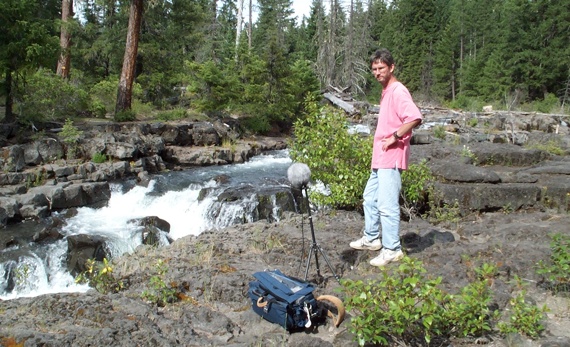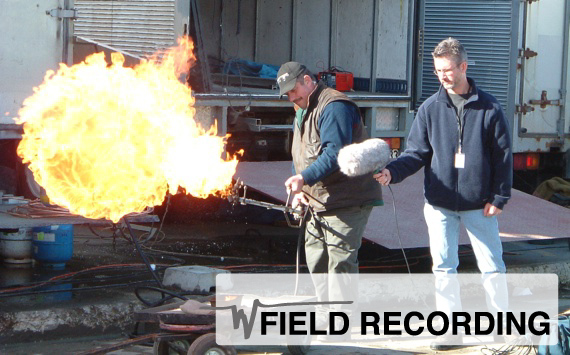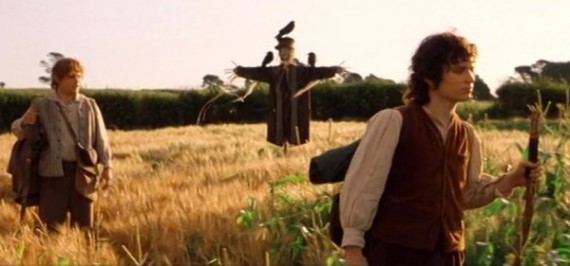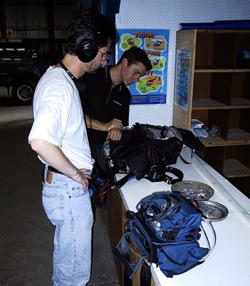I meant to say this in the introduction interview, but these are just my opinions and are not intended to be directions for, or judgements on how anyone else should or does work. One of the great things about working with sound is there are as many approaches to getting the job done, as there are people doing it. If I say something with some conviction that contradicts what you’re doing, don’t take any offense. I only say these things as how they apply to me and my own approach. Far be it from me to tell you how to do what you do. I also change my mind frequently. A year from now I might totally contradict myself on things said now. In fact I hope I do, because my intent with our discussions this month is not to play it safe and spout off cookie-cutter responses. I strive to evolve, but have had pretty strong opinions at every stage of my development. The ones you’re reading this month are only valid for September 2010. :)
OK enough of that.
Field Recording
Collecting original sounds is a priority. It’s a critical part of the process that makes what we do satisfying, at least for me. I’ve always been staunchly anti-commercial library, though I’ve relaxed on that somewhat over the years. I still don’t like using something that the average schmoe might recognize. But sometimes we have to. Sometimes that’s just what the client wants to hear. Sometimes it’s the appropriate sound for the show, but quite often it’s not.
For example, there’s a scene in FOTR (Fellowship of the Ring) where Frodo & Sam are leaving the Shire. They’re out in a field with some crows sitting on a scarecrow. We were playing the mix back for ourselves and I was like “How the @#$% did those Sound Ideas crows get in there???!???!?”. We had a pretty good laugh about it, and no one else seemed to care that much. But I dug in my heels, and my case was, if someone hears a sound that they’ve heard before, even if they don’t realize it, the wrong sound can take them right out of the movie experience. And that was my point. The crow sounds that were in there get used a hundred times a week in TV shows. I didn’t want to risk taking the audience’s attention off screen even for a split second. I wanted to leave them up there with Frodo & Sam. I had recorded some Magpies right outside our studio in Wellington, so we did a fix and used those instead of the library crows. For the rest of the films the guys liked to rib me about it. But it was worth it IMO, even for those silly crows. So get out there and record! That’s one way to make sure you’re using something fresh.
Headphones are for wimps
OK not really, but I get a kick out of saying that. One of the things I’m enjoying this month, is taking the time to reflect on how I go about my work. It’s pretty easy to think you’re doing the same things as everyone else, but when you stop and think about it, we all have at least some things that are not that “normal”. This is one of those areas where I do things differently than just about everyone else. If you’ve seen any of the behind the scenes recording, you may have noticed that I never use headphones when recording. I expect to catch some grief from the readers on this one, but I can’t stand using headphones. In the beginning, I did. Apart from the simple tangle of wires, which I detest, there are some other reasons I stopped wearing headphones. I’ll point out some pros, and also some cons, to recording this way.
A lot of people say that you have to hear what’s going down, to know what you’re getting. I’d say for a production recordist that is true, especially since they’re removed from the source by a physical distance. However that’s rarely the case for the stuff I’m recording. I’m usually right up against the action. And many many times, you’re not hearing JUST the recording, but a blend of the recording and a certain amount of bleed through from the source sound directly. Once several of us were recording the flame bursts from a hot air balloon. One of the recordists thought they had gotten a great recording, because what he heard in his “cans” sounded great. However, when we listened to it later, the recording was pretty badly overmodded. His levels looked good, but the preamps were clipping, and this was even padded. But he couldn’t tell that during recording because the source sound was bleeding through the headphones & masking the distortion in the recording. If you have some extreme isolating headphones, and also monitor really loudly, that would minimize the chance of that happening to you. But I’ve seen it again & again where wearing headphones didn’t prevent this problem. Usually people say something like, “OK that should be good, now let’s get it back to the studio and see what we got.” So IMO headphones are actually a pretty poor judge of what’s going down.
But perhaps the main reason I don’t wear headphones is, I don’t like searching for the sound in the space, with the microphone. In music studio recording, one of the tricks is to walk around in the space while the band is playing. If you find a spot where something sounds good, you stick a mic there. But you search the space with your ears, not the mic. Imagine a “sound gallery” that is like a shooting gallery. You’re standing in the middle of the room and sounds will happen at random locations around you. If you’re wearing headphones, and I’m not, I’ll have my mic pointed at the source before you every time, and likely many times faster.
For example, again, on FOTR several of us went to an Australian possum research facility. It was night, and we went inside a long shed that had several rooms off the hallway where the possums were kept. They could wander around at will, so you never knew where they’d be. We had flashlights but they tended to be more active if it was dark. So, for a couple of hours or so, we walked around recording vocalizations. It was pretty comical to watch the guys wearing headphones trying to figure out where the sound was coming from. One of the possums would let out a screech, and the guys would point their mics in some random direction trying to find it. Needless to say, the vocal would be over before they’d find it. These are extreme examples of why I like this approach, but the benefits are also evident in normal recording situations.
So how do I judge the proximity of the mic to the source if I’m not monitoring it? Good question. I don’t know. I’m not sure if it’s a sense I’ve just developed with trial and error, but I usually get a good feel for where the mic should be. There’s something very tactile about micing this way. For something like a tiger growl that is extremely powerful, you can literally feel where the mic ought to be.
Now for the cons. Yep you have to be a bit of a banzai to record this way, but I’ve been doing it for 20 years and I intend to keep doing it despite the pitfalls. Once I was at a horse ranch to record some horse vocals. I had a Sound Devices MP-2 hooked up to a Sony M1, and both were powered by a fully charged Eco-charge battery. That rig could run for over 10 hours straight. I had my trusty 416 mic ready to rock (still one of my favorite mono mics). I set my levels, put myself in record, locked the buttons so it couldn’t accidentally turn off, and triple checked that the DAT counter was rolling. It was. So I took the grand tour, and got some great stuff. It was by far the best horse vocal session I had done to date. I was thrilled and couldn’t wait to get back & load the DAT. That was until I saw that the DAT had turned off, literally less than 20 seconds after it started recording. There was a short in the power cable going from the DAT to the eco-charge. I missed it all. We hadn’t even started walking yet when it had turned off. I had checked the pre-amp meters several times during the recording, and they were fine. Of course that didn’t matter since the DAT was powered off! Big strike there against not wearing headphones huh? That scenario wouldn’t be as common these days since most rigs are preamp & disk recorder all in one. Another time, there was a similar issue, but the mic had popped out of one end of the clip inside the zeppelin. So I wound up with a lot of mic bumps in the recording that I couldn’t hear or feel while I was doing the takes.
So there are the cons. IMO they are purely technical issues, and have little to do with the art of getting a sound recorded. For me, recording without headphones, and hearing the source in its own space gets the results I prefer, even when compared to another take of the same source made by another recordist.

Set it and forget it
I don’t muck around with my levels while recording. I have a couple of settings that I generally use, and it’s basically one for really loud stuff, and one for quiet, like ambiences. In the old days on DAT, lots of people were obsessed with making sure the meters were topping off. This had to do mostly with being afraid of recording at low levels on 16-bit. Except for extreme low levels, I never had any issues with recording lower to tape. In fact, I usually record leaving plenty of room for peaks, both then & now. I can’t stand getting a recording back from someone and finding that they were riding the levels. It’s never smooth enough, so just let us take care of that on the back end. It’s incredibly difficult to correct something where the levels were ridden incorrectly. This was worse back in the DAT days where people recorded hot. They’d see something start to clip and back off the levels. Right there – the recording is already ruined IMO. So my approach has always been to record at a low enough level that it won’t ever clip, and don’t touch the levels during a take. If something happens to clip, I just let it ride and then back off the level for the next take. There are some decent tools nowadays to repair clipping so I’ll give that a try (again Izotope RX). If I have to try to fix a level ride, I just won’t bother.
With 24-bit, we can record at lower levels without the worry about getting into dither issues like we had with 16-bit. From the “tweakheadz” site:
“Bit Depth refers to the number of bits you have to capture audio. The easiest way to envision this is as a series of levels, that audio energy can be sliced at any given moment in time. With 16 bit audio, there are 65,536 possible levels. With every bit of greater resolution, the number of levels double. By the time we get to 24 bit, we actually have 16,777,216 levels. Remember we are talking about a slice of audio frozen in a single moment of time. ”
I always record at 24-bit these days. To me, that’s a much better improvement than 96k. Don’t get me wrong, 96k is better than 48k, but it’s not twice as good like it reads. It’s still only one octave higher than 48k. Yes it’s better than 48 when pitching for those frequencies that are normally out of our range of hearing, but in my experience, the significance of the improvement is minor. I don’t typically pitch things down very far. When things slow down, they lose energy, and by the time I’ve slowed things down to where 96k shows an improvement, it’s usually lost more energy than I want. Now real-time pitching (where the timing stays the same) may someday provide the benefit I’m hoping for. Having said that, I DO record at 96k 24-bit, even when using mics that don’t have an extended upper range. It’s mostly for the “just in case” scenario though, rather than having seen significant benefits across the board. And with storage space being dirt cheap these days, why not record at 96k?
I know some people are going to take issue with my position on 96k, so let me just say again that I do agree it is better. I may change my opinion on it, but I’ve been working with it since about 2004, and with extended range mics as well. It’s the significance of the difference that I have not found to be as great as I’d hoped. Though YMMV
Written by David Farmer for Designing Sound



Great stuff! I guess I’ve never really thought about that take on headphones. And about the sample rate, I now always record in 24/192. I prefer the accurate high end. And I love seeing what happens at extreme pitch downs… But you are definitely right about the loss of energy there.
Great article! Dave speaks the truth. Don’t touch the damn levels while recording, please, it is the worst thing you can do (besides forgetting to press record).
16bit vs 24bit, Dave is spot on. I’ve noticed the number of analog vs digital arguments have dropped significantly since we’ve moved to 24 bit recording. And it’s because 24 bit just sounds soooo much better than 16 bit, so it’s harder for the analog heads to prove their point :) I can hardly even listen to my old dat recordings anymore!
No headphones? Rebel! :)
Awesome article. I totally agree with the no headphones idea. I go without them all the time when recording. Sometimes it’s hard to wear them especially when roaming around dangerous rock cliffs, the wires can trip you up!
I did miss some some great rockslides one time when I thought I pressed record. A real loss, had to go back for more later.
This article is gold Dave! I also never use headphones with portable recorders like the PCM D-50 probably because it stays in the pocket all the time and is used to shoot sounds on the fly. It totally make sense when you’re in the dark and can’t predict where the source is (other example: bat caves).
“So get out there and record!” I wish more producers said that…
Amazing article!
I would love to be able to record with no headphones in the heat of Florida, but I just can’t bring myself to do it! Maybe I’ll go try it out a few times and see what happens. I would at least need them with me to monitor playback between takes though.
David, Thanks so much for sharing your experince. Reading your perspctive and your approach are refreshing and inspiring to me, being such a big fan. So with out geeking and ranting on about everything I’ve taken in, I’ll just say thanks.
Thanks.
Thank you, David.
I use a hybrid method when recording music where I walk around the room with no headphones and then put on headphones, take them off, put them on, take them off and tweak the position that way.
Very interesting. Thanks for sharing!
Great article, i like your approach to field recording & sound design. I also rarely monitor during location recording of sfx for similar reasons.
Great stuff David! It is great to hear new approaches to such a basic part of a sound designer’s work that is recording. I must admit I would find it hard to go out without headphones as I find it greatly affects the quality of the sounds I capture and where I place my microphone. But then again it could be due to not being around doing this for 20 years yet and therefore not being as confident.
Anyways, thanks for the article.Great stuff and can’t wait to read more!
Great article, thanks. Love the tips you’ve given, some great things to think about.
Thanks for the article David
Very interesting point of view
About using headphones.
Great stuff!
So true about hunting for the source of a sound with headphones on! Man, now I feel like an idiot…
Nice David! Regarding headphones versus no headphones, I do both (sometimes opening one ear or the other). For extremely loud recordings I use my Remote Audio set. Keeping your levels on the low side Is Key. You can’t believe how many people have clipped recordings. Thanks for the great article!
PS, I hate crows! They have ruined a number of crucial “once in a lifetime” takes! :-(
Awesome article Dave, some really good tips in here. I have recently been recording with custom In Ear Monitors by JH-audio and Ultimate Ears (JH-16’s,UE-18’s & the new UE-Reference Monitors), I am surprised that no one else here has tried this, as the sonic precision you are able to hear with these is phenomenal especially when recording at high sample rates 96/192k. They are like having super sonic hearing aids. Whats interesting about this new technology is that you won’t ever get audio bleed through the headphones as they are already molded to fit perfectly inside your ear canals, isolating up to 26-32db’s of outside noise, no feedback/audio bleed, nothing its as if your hearing the incoming audio inside your head literally.
lol. I feel justified in a lot of my practices now. I won’t ever throw away the headphones (I still like to at least do a quick confidence check every now and then), but I use them somewhat selectively when field recording…depending on the situation. There are plenty of times I just don’t bother with throwing them on.
Headphones rule….both for recording and listening. They are a “viewfinder” for the mic and a totally immersive listening experience for the finished edit. Speakers are ugly, expensive and can never be accurate and are for those who like to listen to the kit and not the sounds.
And you think headphones are accurate?!